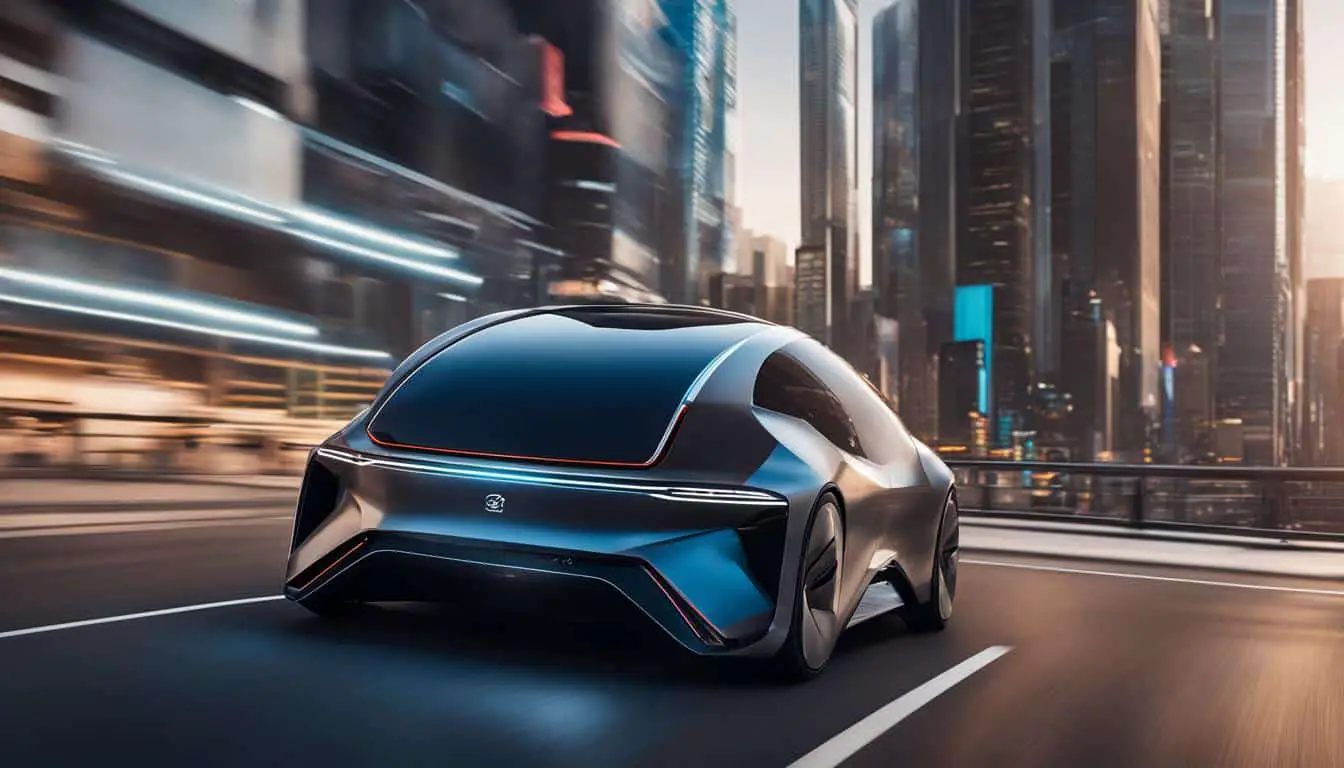
Welcome to the exciting world of autonomous vehicles, where artificial intelligence (AI) takes the wheel and revolutionizes transportation as we know it. Self-driving cars are not just a futuristic concept anymore; they are rapidly becoming a reality, thanks to the advancements in AI technology for autonomous vehicles.
Advanced driver-assistance systems (ADAS) and automated driving technology are paving the way for fully autonomous vehicles. With machine learning algorithms at their core, these AI-powered autonomous vehicles have the potential to transform the way we commute, work, and live.
But what exactly does the future hold for autonomous vehicles? Let’s explore the latest industry trends and advancements in autonomous vehicle technology.
Key Takeaways:
- Autonomous vehicles powered by AI technology are set to revolutionize transportation.
- Advanced driver-assistance systems (ADAS) play a crucial role in the development of autonomous vehicles.
- Machine learning algorithms enable autonomous vehicles to navigate and make decisions.
- The autonomous vehicle industry is experiencing rapid advancements and growth.
- Consumer adoption, safety concerns, and regulatory challenges are among the factors influencing the widespread adoption of autonomous vehicles.
The Potential of Autonomous Vehicles in Transforming the Passenger Car Market
The autonomous vehicle industry is poised to revolutionize the passenger car market, offering a glimpse into a future where self-driving cars are a common sight on our roads. With advancements in AI technology, autonomous vehicles have the potential to transform transportation as we know it.
Consumer adoption of autonomous features is a critical factor in the success of autonomous vehicles. According to projections, by 2030 and 2035, there will be a significant increase in the adoption of Level 3+ autonomous driving functions in new passenger cars. This increase is driven by consumer demand for hands-free driving and the continuous improvements in sensors, computing power, and safety standards.
Automakers are focusing on delivering vehicles with Level 3 and Level 4 autonomous systems, specifically for driving on highways. However, they also need to strike a balance between the upfront costs of developing these advanced systems and the commercial potential of offering Level 2+ systems. Several automakers already offer Level 2+ systems, which can contribute to the development and refinement of higher-level autonomous systems.
In addition to consumer interest, the potential revenue generated by autonomous vehicles is a significant driving factor for automakers. The passenger car market could see revenue potential ranging from hundreds of billions to trillions of dollars. This revenue potential extends not only to the sale of autonomous vehicles but also to ancillary industries such as insurance, roadside assistance, and more.
| Autonomous System Level | Description |
|---|---|
| Level 0 | No automation |
| Level 1 | Driver assistance |
| Level 2 | Partial automation |
| Level 3 | Conditional automation |
| Level 4 | High automation |
| Level 5 | Full automation |
With the potential to reduce accidents, improve convenience, and increase productivity, autonomous vehicles have a bright future ahead. However, there are still challenges to overcome, including regulatory hurdles, safety concerns, and technological advancements. As the autonomous vehicle market continues to evolve, it is essential for automakers and policymakers to work together to realize the full potential of this transformative technology.
Innovations and Advancements in Autonomous Vehicle Technology
In the rapidly evolving world of autonomous vehicles, innovative technologies continue to push boundaries and redefine personal transport. One remarkable example is the Airo electric car, which seamlessly transitions between autonomous and driver-controlled modes. Equipped with HEPA filters, this eco-friendly vehicle not only provides a smooth ride but also purifies the air for a healthier driving experience.
Electric vehicles (EVs) have become a key focus in the pursuit of sustainable transportation. With zero emissions and advancements in battery technology, EVs have the potential to significantly reduce our carbon footprint. As the industry moves forward, future cars are being designed with sustainable features, ensuring a greener and cleaner future.
Autonomous vehicles are not limited to passenger cars alone. In the logistics industry, autonomous freight mobility technology is revolutionizing long-haul transportation. Companies like Einride are leading the way by developing electric and autonomous trucks that not only reduce carbon emissions but also enhance efficiency in the supply chain. Utilizing 5G-enabled technology, these trucks can be remotely controlled, paving the way for a more streamlined and responsive logistics infrastructure.
Aside from practical applications, autonomous vehicles also have a place in exciting realms like motorsport. Autonomous race cars, such as those showcased in Roborace, offer a glimpse into the future of racing. With the integration of Artificial Intelligence (AI) and augmented reality, these vehicles not only prioritize safety but also provide an exhilarating experience for fans. AI’s role in motorsport extends beyond autonomous racing, as it continues to push the limits of driving and enhance the overall fan engagement.
While the advancements in autonomous vehicle technology bring numerous benefits, the potential impact on job displacement cannot be overlooked. As automation takes over certain tasks, the transportation industry will need to adapt and create new roles that complement the hybrid approach to autonomous vehicles. This synergy between human oversight and AI-driven technology ensures a harmonious balance between efficiency and safety in the world of autonomous transportation.
FAQ
What is the potential of autonomous driving (AD)?
Autonomous driving has the potential to transform transportation, consumer behavior, and society at large.
How much value could autonomous driving generate for the auto industry?
It is estimated that autonomous driving could generate hundreds of billions of dollars for the auto industry by the end of this decade.
What do auto OEMs and suppliers need to do to realize the benefits of autonomous driving?
Auto OEMs and suppliers need to develop new sales and business strategies, acquire new technological capabilities, and address safety concerns.
What are the potential benefits of autonomous driving for consumers?
Autonomous driving can offer increased convenience, safety, and productivity for consumers.
How do advanced driver-assistance systems (ADAS) impact accidents?
ADAS can significantly reduce accidents and improve road safety.
What is the revenue potential of ADAS and AD in the passenger car market?
ADAS and AD have a revenue potential estimated to be between $300 billion and $400 billion by 2035.
How can autonomous cars impact other industries?
Autonomous cars can have an impact on industries such as roadside assistance and insurance.
What are the obstacles to widespread adoption of autonomous vehicles?
Regulatory fragmentation and navigating obstacles are challenges that automakers need to overcome for widespread adoption of autonomous vehicles.
What is the disruptive potential of autonomous technologies in the passenger car market?
Autonomous technologies have the potential to disrupt the passenger car market.
What are the scenarios for autonomous-passenger car sales?
There are three scenarios based on levels of technology availability, customer adoption, and regulatory support.
What are the projected figures for the adoption of L3+ AD functions in new passenger cars?
By 2030 and 2035, there is a projected increase in the adoption of L3+ AD functions in new passenger cars.
What factors drive the development of higher levels of automation in vehicles?
Consumer demand for hands-free driving and advancements in sensors, computing power, and safety standards drive the development of higher levels of vehicle automation.
What is the focus of automakers in delivering autonomous driving systems?
Automakers are focusing on delivering vehicles with L3 and L4 systems for driving on highways in the private-passenger-car segment.
How do automakers balance the costs and commercial potential of autonomous driving systems?
Automakers need to balance the upfront costs of developing L3 and L4 systems with the commercial potential of offering L2+ systems.
Are L2+ systems available from automakers?
Yes, several automakers offer L2+ systems, and these systems contribute to the development of L3 systems.
Are consumers interested in autonomous driving features?
Yes, there is consumer interest in autonomous driving features, and consumers are willing to pay for them.
What are the potential benefits of autonomous vehicles?
Autonomous vehicles can reduce highway fatalities and injuries, mitigate traffic congestion, and decrease air pollution.
What are some innovations in autonomous vehicle technology?
Innovations include the Airo electric car with autonomous and driver-controlled modes and air-cleaning capabilities.
What is the potential of electric vehicles in reducing environmental impact?
Electric vehicles have the potential to significantly reduce environmental impact, and future car designs include sustainable features.
How are autonomous vehicles used in the logistics industry?
Autonomous vehicles are used, particularly in long-haul transportation, to reduce carbon emissions and increase efficiency in the logistics industry.
What companies are leading the way in autonomous freight mobility technology?
Companies like Einride are leading the way in electric and autonomous freight mobility technology.
How is 5G-enabled technology used in controlling autonomous trucks?
5G-enabled technology is used to control multiple autonomous trucks remotely, improving efficiency and safety.
What are the benefits of autonomous race cars?
Autonomous race cars offer enhanced safety, speed, and fan engagement in motorsport.
What is the potential role of Artificial Intelligence (AI) in motorsport?
AI can push the limits of driving and enhance the fan experience in motorsport.
What potential impact can autonomous vehicles have on job displacement in the transportation industry?
Autonomous vehicles have the potential to impact job displacement in the transportation industry.
What is the hybrid approach to autonomous vehicles?
The hybrid approach combines autonomy with human oversight and decision-making in autonomous vehicles.
Source Links
- https://www.brookings.edu/articles/securing-the-future-of-driverless-cars/
- https://www.mckinsey.com/industries/automotive-and-assembly/our-insights/autonomous-drivings-future-convenient-and-connected
- https://technologymagazine.com/digital-transformation/replacing-the-human-driver-the-future-of-autonomous-driving








